Applied Corporate Strategy: Sainsbury's Innovation Report Analysis
VerifiedAdded on 2023/01/12
|14
|4030
|42
Report
AI Summary
This report offers a comprehensive analysis of Sainsbury's, a major retail organization, and its approach to innovation. It begins by defining innovation and exploring relevant theories, including the Diffusion of Innovation and Disruptive Innovation theories. The report delves into the definitions, principles, and processes associated with each theory, along with their respective benefits and limitations. It then examines the application of these theories in the historical development of Sainsbury's products and services. The report also provides a detailed overview of Sainsbury's business model, its evolution, and its strategic responses to market changes. Finally, it considers Sainsbury's future development plans concerning innovation, offering insights into the company's strategic direction. The report leverages the business canvas model to illustrate Sainsbury's market position and offers an evaluation of its past strategies, providing a clear understanding of how Sainsbury's uses innovation to maintain its competitive edge.
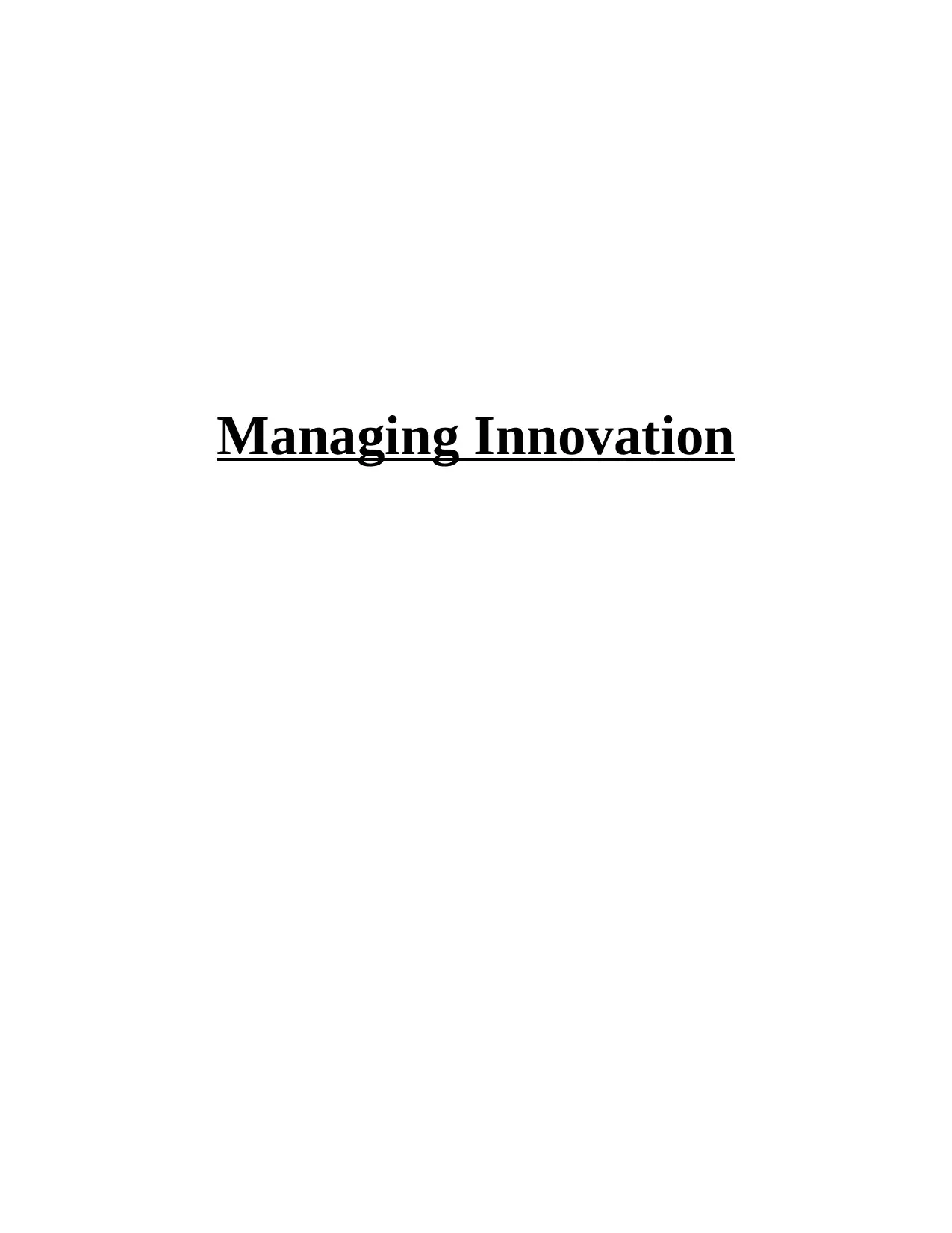
Managing Innovation
Paraphrase This Document
Need a fresh take? Get an instant paraphrase of this document with our AI Paraphraser
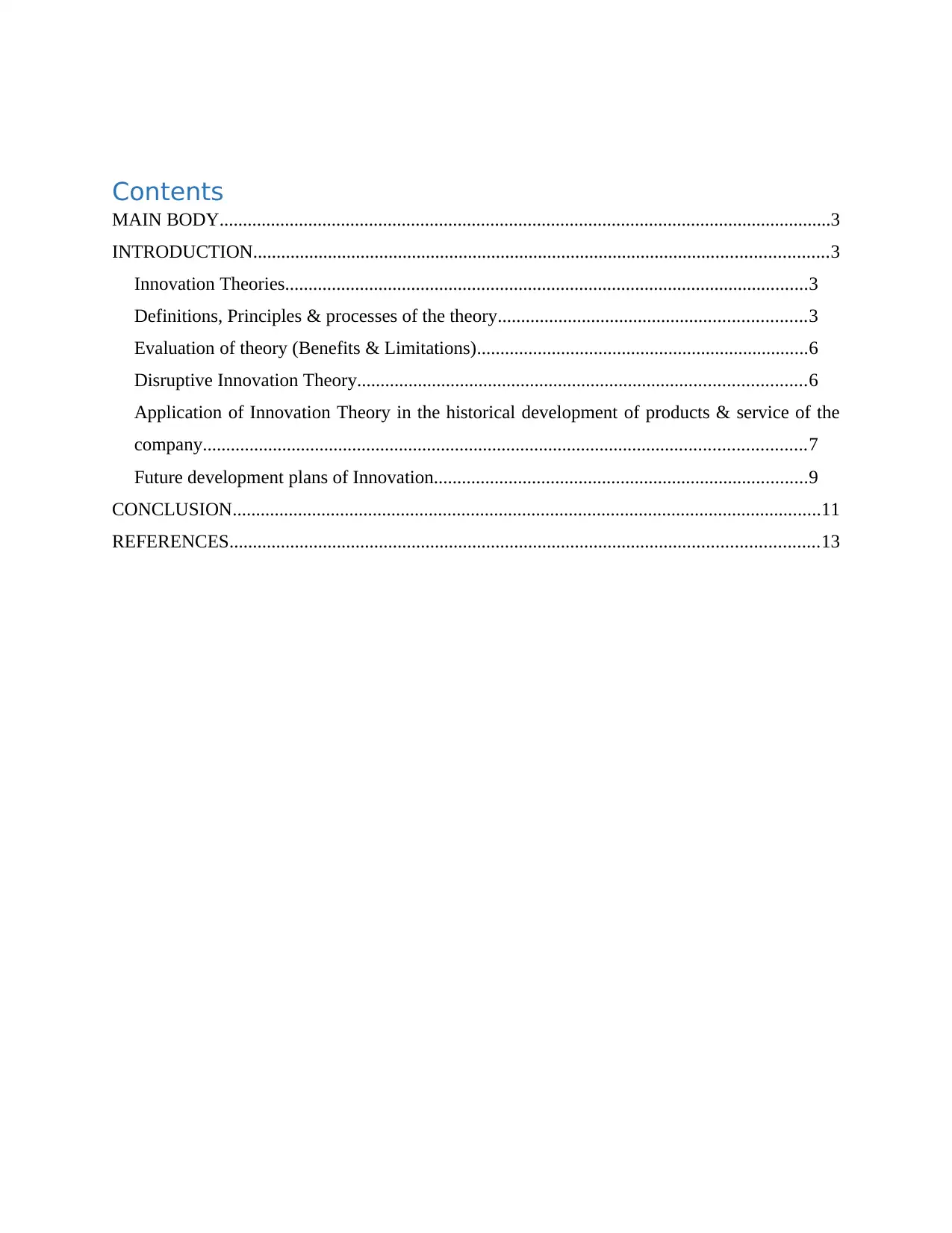
Contents
MAIN BODY...................................................................................................................................3
INTRODUCTION...........................................................................................................................3
Innovation Theories................................................................................................................3
Definitions, Principles & processes of the theory..................................................................3
Evaluation of theory (Benefits & Limitations).......................................................................6
Disruptive Innovation Theory................................................................................................6
Application of Innovation Theory in the historical development of products & service of the
company.................................................................................................................................7
Future development plans of Innovation................................................................................9
CONCLUSION..............................................................................................................................11
REFERENCES..............................................................................................................................13
MAIN BODY...................................................................................................................................3
INTRODUCTION...........................................................................................................................3
Innovation Theories................................................................................................................3
Definitions, Principles & processes of the theory..................................................................3
Evaluation of theory (Benefits & Limitations).......................................................................6
Disruptive Innovation Theory................................................................................................6
Application of Innovation Theory in the historical development of products & service of the
company.................................................................................................................................7
Future development plans of Innovation................................................................................9
CONCLUSION..............................................................................................................................11
REFERENCES..............................................................................................................................13
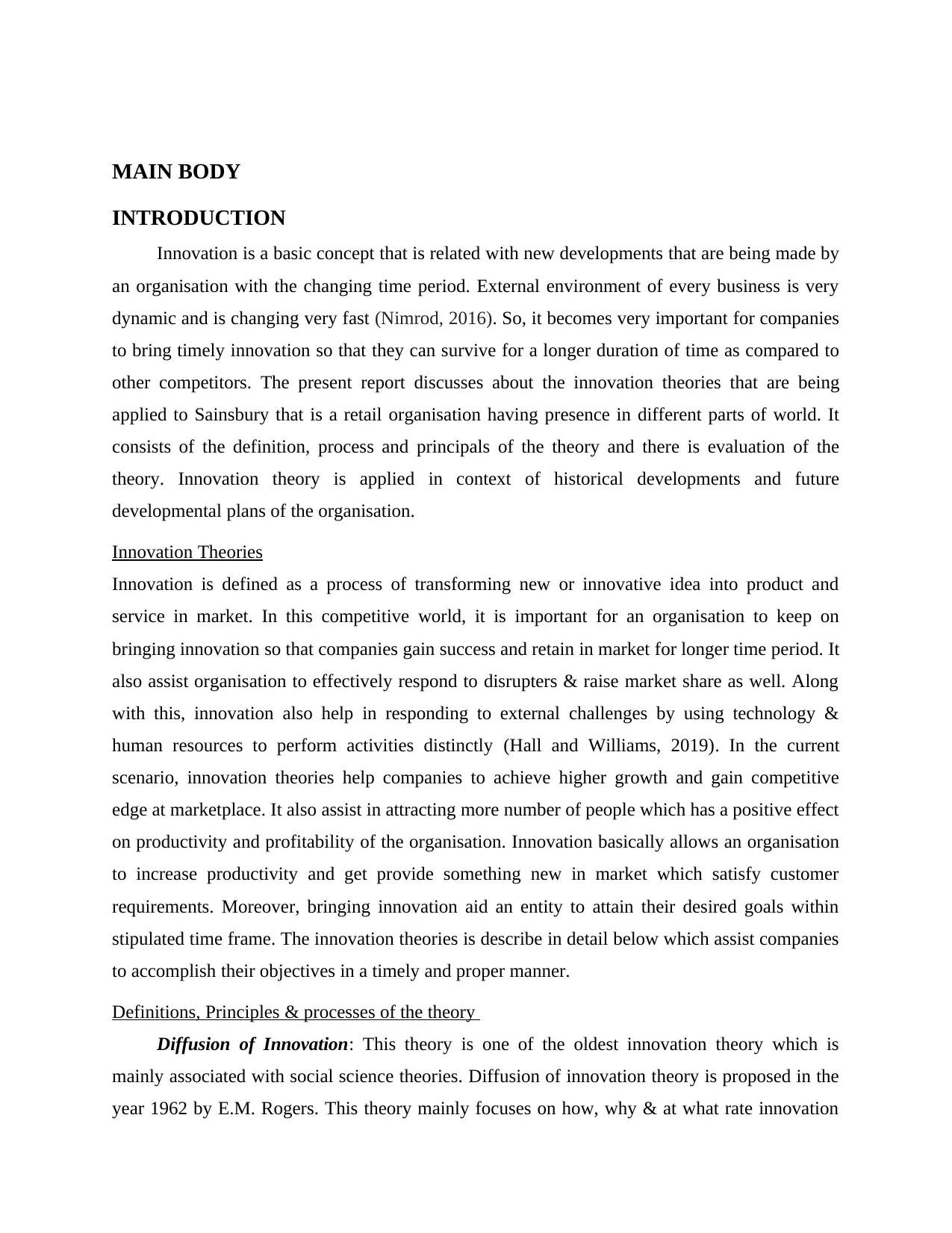
MAIN BODY
INTRODUCTION
Innovation is a basic concept that is related with new developments that are being made by
an organisation with the changing time period. External environment of every business is very
dynamic and is changing very fast (Nimrod, 2016). So, it becomes very important for companies
to bring timely innovation so that they can survive for a longer duration of time as compared to
other competitors. The present report discusses about the innovation theories that are being
applied to Sainsbury that is a retail organisation having presence in different parts of world. It
consists of the definition, process and principals of the theory and there is evaluation of the
theory. Innovation theory is applied in context of historical developments and future
developmental plans of the organisation.
Innovation Theories
Innovation is defined as a process of transforming new or innovative idea into product and
service in market. In this competitive world, it is important for an organisation to keep on
bringing innovation so that companies gain success and retain in market for longer time period. It
also assist organisation to effectively respond to disrupters & raise market share as well. Along
with this, innovation also help in responding to external challenges by using technology &
human resources to perform activities distinctly (Hall and Williams, 2019). In the current
scenario, innovation theories help companies to achieve higher growth and gain competitive
edge at marketplace. It also assist in attracting more number of people which has a positive effect
on productivity and profitability of the organisation. Innovation basically allows an organisation
to increase productivity and get provide something new in market which satisfy customer
requirements. Moreover, bringing innovation aid an entity to attain their desired goals within
stipulated time frame. The innovation theories is describe in detail below which assist companies
to accomplish their objectives in a timely and proper manner.
Definitions, Principles & processes of the theory
Diffusion of Innovation: This theory is one of the oldest innovation theory which is
mainly associated with social science theories. Diffusion of innovation theory is proposed in the
year 1962 by E.M. Rogers. This theory mainly focuses on how, why & at what rate innovation
INTRODUCTION
Innovation is a basic concept that is related with new developments that are being made by
an organisation with the changing time period. External environment of every business is very
dynamic and is changing very fast (Nimrod, 2016). So, it becomes very important for companies
to bring timely innovation so that they can survive for a longer duration of time as compared to
other competitors. The present report discusses about the innovation theories that are being
applied to Sainsbury that is a retail organisation having presence in different parts of world. It
consists of the definition, process and principals of the theory and there is evaluation of the
theory. Innovation theory is applied in context of historical developments and future
developmental plans of the organisation.
Innovation Theories
Innovation is defined as a process of transforming new or innovative idea into product and
service in market. In this competitive world, it is important for an organisation to keep on
bringing innovation so that companies gain success and retain in market for longer time period. It
also assist organisation to effectively respond to disrupters & raise market share as well. Along
with this, innovation also help in responding to external challenges by using technology &
human resources to perform activities distinctly (Hall and Williams, 2019). In the current
scenario, innovation theories help companies to achieve higher growth and gain competitive
edge at marketplace. It also assist in attracting more number of people which has a positive effect
on productivity and profitability of the organisation. Innovation basically allows an organisation
to increase productivity and get provide something new in market which satisfy customer
requirements. Moreover, bringing innovation aid an entity to attain their desired goals within
stipulated time frame. The innovation theories is describe in detail below which assist companies
to accomplish their objectives in a timely and proper manner.
Definitions, Principles & processes of the theory
Diffusion of Innovation: This theory is one of the oldest innovation theory which is
mainly associated with social science theories. Diffusion of innovation theory is proposed in the
year 1962 by E.M. Rogers. This theory mainly focuses on how, why & at what rate innovation
⊘ This is a preview!⊘
Do you want full access?
Subscribe today to unlock all pages.

Trusted by 1+ million students worldwide
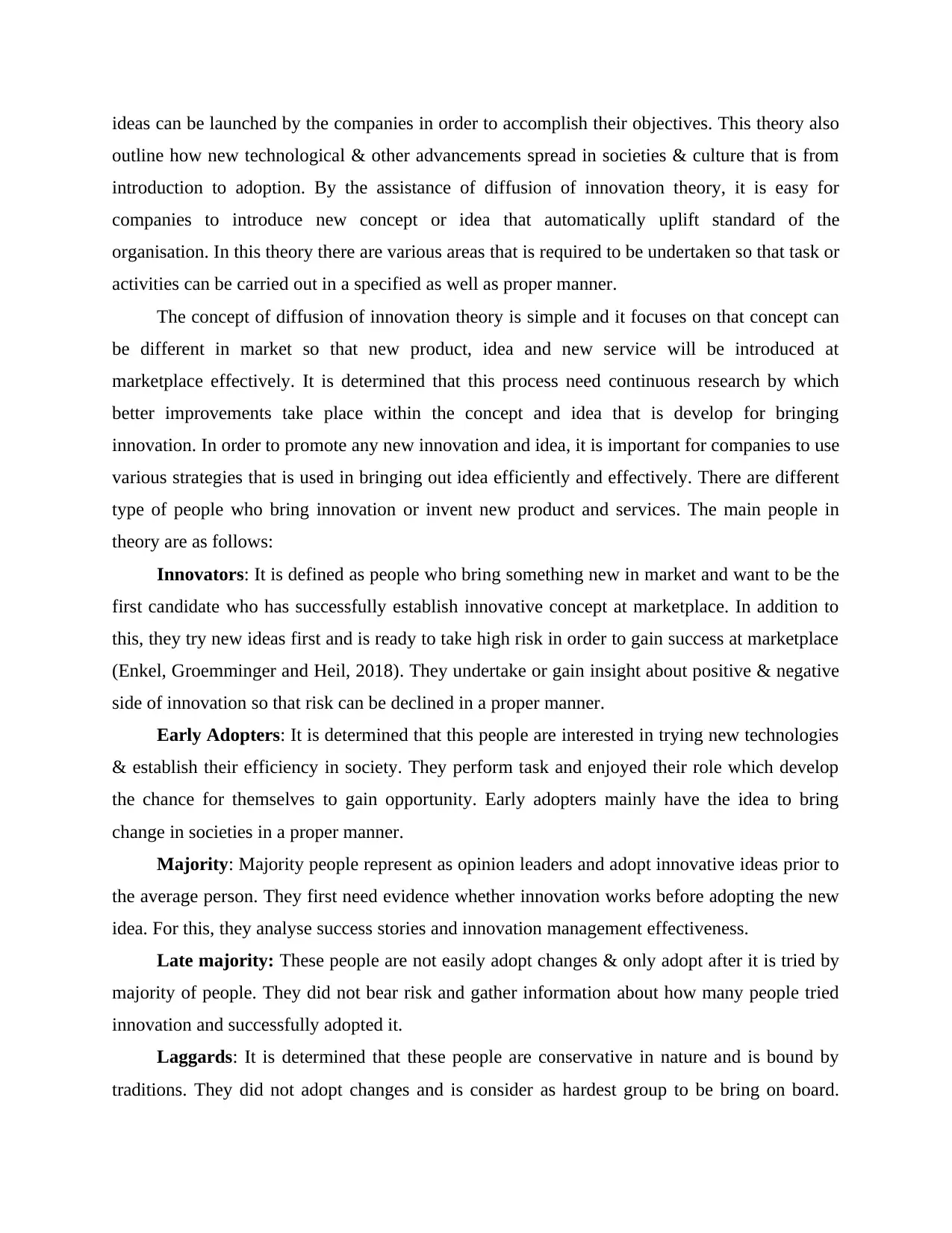
ideas can be launched by the companies in order to accomplish their objectives. This theory also
outline how new technological & other advancements spread in societies & culture that is from
introduction to adoption. By the assistance of diffusion of innovation theory, it is easy for
companies to introduce new concept or idea that automatically uplift standard of the
organisation. In this theory there are various areas that is required to be undertaken so that task or
activities can be carried out in a specified as well as proper manner.
The concept of diffusion of innovation theory is simple and it focuses on that concept can
be different in market so that new product, idea and new service will be introduced at
marketplace effectively. It is determined that this process need continuous research by which
better improvements take place within the concept and idea that is develop for bringing
innovation. In order to promote any new innovation and idea, it is important for companies to use
various strategies that is used in bringing out idea efficiently and effectively. There are different
type of people who bring innovation or invent new product and services. The main people in
theory are as follows:
Innovators: It is defined as people who bring something new in market and want to be the
first candidate who has successfully establish innovative concept at marketplace. In addition to
this, they try new ideas first and is ready to take high risk in order to gain success at marketplace
(Enkel, Groemminger and Heil, 2018). They undertake or gain insight about positive & negative
side of innovation so that risk can be declined in a proper manner.
Early Adopters: It is determined that this people are interested in trying new technologies
& establish their efficiency in society. They perform task and enjoyed their role which develop
the chance for themselves to gain opportunity. Early adopters mainly have the idea to bring
change in societies in a proper manner.
Majority: Majority people represent as opinion leaders and adopt innovative ideas prior to
the average person. They first need evidence whether innovation works before adopting the new
idea. For this, they analyse success stories and innovation management effectiveness.
Late majority: These people are not easily adopt changes & only adopt after it is tried by
majority of people. They did not bear risk and gather information about how many people tried
innovation and successfully adopted it.
Laggards: It is determined that these people are conservative in nature and is bound by
traditions. They did not adopt changes and is consider as hardest group to be bring on board.
outline how new technological & other advancements spread in societies & culture that is from
introduction to adoption. By the assistance of diffusion of innovation theory, it is easy for
companies to introduce new concept or idea that automatically uplift standard of the
organisation. In this theory there are various areas that is required to be undertaken so that task or
activities can be carried out in a specified as well as proper manner.
The concept of diffusion of innovation theory is simple and it focuses on that concept can
be different in market so that new product, idea and new service will be introduced at
marketplace effectively. It is determined that this process need continuous research by which
better improvements take place within the concept and idea that is develop for bringing
innovation. In order to promote any new innovation and idea, it is important for companies to use
various strategies that is used in bringing out idea efficiently and effectively. There are different
type of people who bring innovation or invent new product and services. The main people in
theory are as follows:
Innovators: It is defined as people who bring something new in market and want to be the
first candidate who has successfully establish innovative concept at marketplace. In addition to
this, they try new ideas first and is ready to take high risk in order to gain success at marketplace
(Enkel, Groemminger and Heil, 2018). They undertake or gain insight about positive & negative
side of innovation so that risk can be declined in a proper manner.
Early Adopters: It is determined that this people are interested in trying new technologies
& establish their efficiency in society. They perform task and enjoyed their role which develop
the chance for themselves to gain opportunity. Early adopters mainly have the idea to bring
change in societies in a proper manner.
Majority: Majority people represent as opinion leaders and adopt innovative ideas prior to
the average person. They first need evidence whether innovation works before adopting the new
idea. For this, they analyse success stories and innovation management effectiveness.
Late majority: These people are not easily adopt changes & only adopt after it is tried by
majority of people. They did not bear risk and gather information about how many people tried
innovation and successfully adopted it.
Laggards: It is determined that these people are conservative in nature and is bound by
traditions. They did not adopt changes and is consider as hardest group to be bring on board.
Paraphrase This Document
Need a fresh take? Get an instant paraphrase of this document with our AI Paraphraser
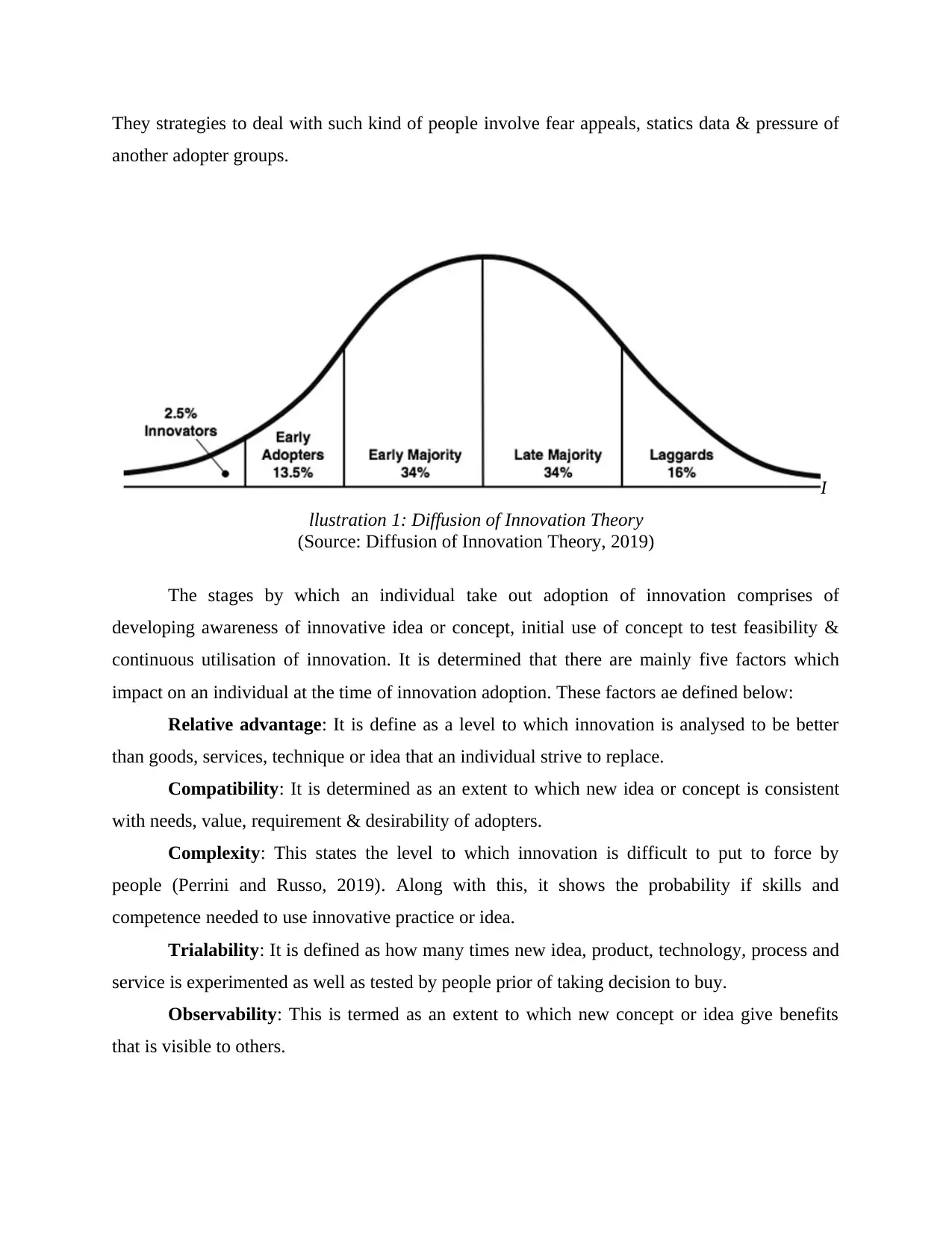
They strategies to deal with such kind of people involve fear appeals, statics data & pressure of
another adopter groups.
(Source: Diffusion of Innovation Theory, 2019)
The stages by which an individual take out adoption of innovation comprises of
developing awareness of innovative idea or concept, initial use of concept to test feasibility &
continuous utilisation of innovation. It is determined that there are mainly five factors which
impact on an individual at the time of innovation adoption. These factors ae defined below:
Relative advantage: It is define as a level to which innovation is analysed to be better
than goods, services, technique or idea that an individual strive to replace.
Compatibility: It is determined as an extent to which new idea or concept is consistent
with needs, value, requirement & desirability of adopters.
Complexity: This states the level to which innovation is difficult to put to force by
people (Perrini and Russo, 2019). Along with this, it shows the probability if skills and
competence needed to use innovative practice or idea.
Trialability: It is defined as how many times new idea, product, technology, process and
service is experimented as well as tested by people prior of taking decision to buy.
Observability: This is termed as an extent to which new concept or idea give benefits
that is visible to others.
I
llustration 1: Diffusion of Innovation Theory
another adopter groups.
(Source: Diffusion of Innovation Theory, 2019)
The stages by which an individual take out adoption of innovation comprises of
developing awareness of innovative idea or concept, initial use of concept to test feasibility &
continuous utilisation of innovation. It is determined that there are mainly five factors which
impact on an individual at the time of innovation adoption. These factors ae defined below:
Relative advantage: It is define as a level to which innovation is analysed to be better
than goods, services, technique or idea that an individual strive to replace.
Compatibility: It is determined as an extent to which new idea or concept is consistent
with needs, value, requirement & desirability of adopters.
Complexity: This states the level to which innovation is difficult to put to force by
people (Perrini and Russo, 2019). Along with this, it shows the probability if skills and
competence needed to use innovative practice or idea.
Trialability: It is defined as how many times new idea, product, technology, process and
service is experimented as well as tested by people prior of taking decision to buy.
Observability: This is termed as an extent to which new concept or idea give benefits
that is visible to others.
I
llustration 1: Diffusion of Innovation Theory
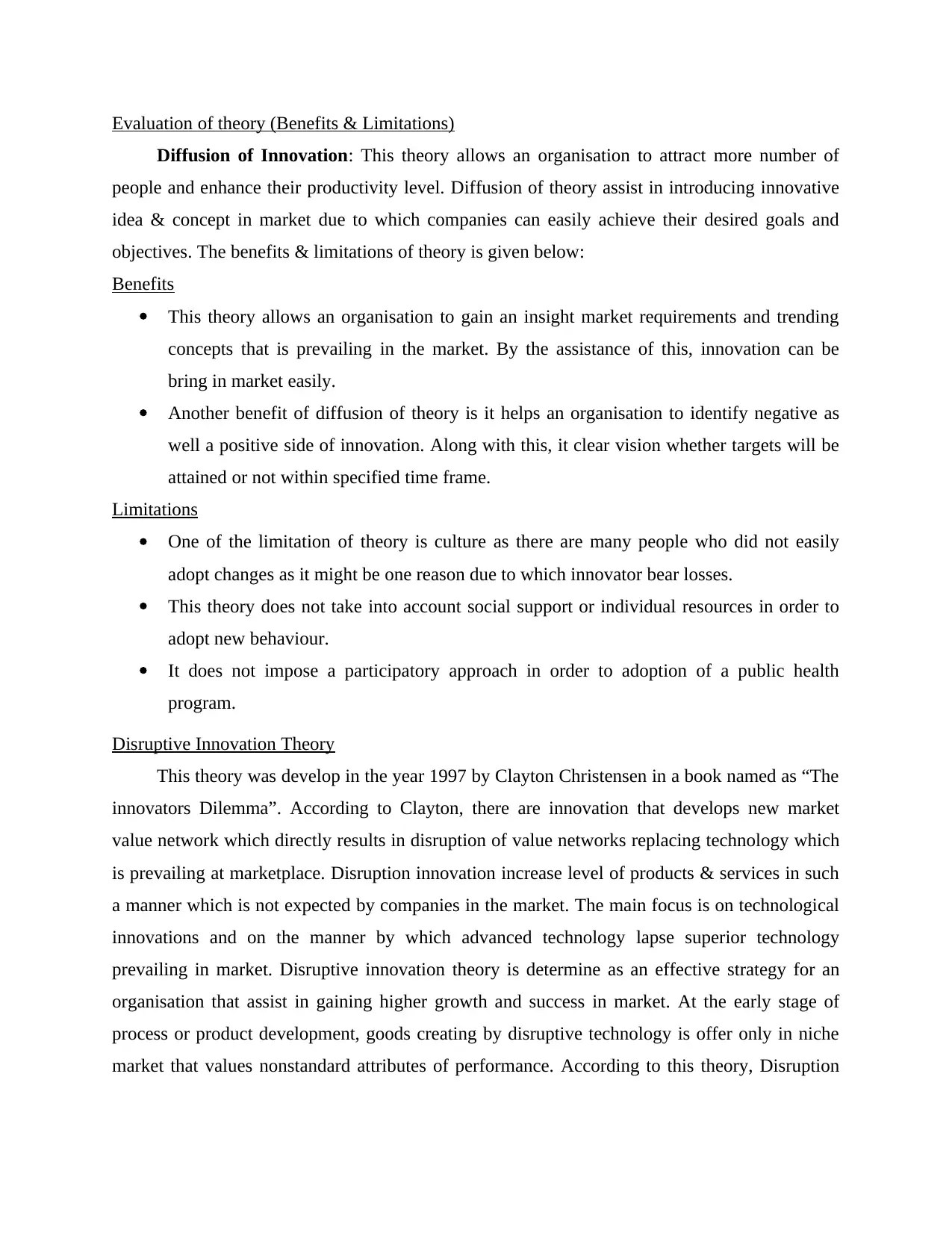
Evaluation of theory (Benefits & Limitations)
Diffusion of Innovation: This theory allows an organisation to attract more number of
people and enhance their productivity level. Diffusion of theory assist in introducing innovative
idea & concept in market due to which companies can easily achieve their desired goals and
objectives. The benefits & limitations of theory is given below:
Benefits
This theory allows an organisation to gain an insight market requirements and trending
concepts that is prevailing in the market. By the assistance of this, innovation can be
bring in market easily.
Another benefit of diffusion of theory is it helps an organisation to identify negative as
well a positive side of innovation. Along with this, it clear vision whether targets will be
attained or not within specified time frame.
Limitations
One of the limitation of theory is culture as there are many people who did not easily
adopt changes as it might be one reason due to which innovator bear losses.
This theory does not take into account social support or individual resources in order to
adopt new behaviour.
It does not impose a participatory approach in order to adoption of a public health
program.
Disruptive Innovation Theory
This theory was develop in the year 1997 by Clayton Christensen in a book named as “The
innovators Dilemma”. According to Clayton, there are innovation that develops new market
value network which directly results in disruption of value networks replacing technology which
is prevailing at marketplace. Disruption innovation increase level of products & services in such
a manner which is not expected by companies in the market. The main focus is on technological
innovations and on the manner by which advanced technology lapse superior technology
prevailing in market. Disruptive innovation theory is determine as an effective strategy for an
organisation that assist in gaining higher growth and success in market. At the early stage of
process or product development, goods creating by disruptive technology is offer only in niche
market that values nonstandard attributes of performance. According to this theory, Disruption
Diffusion of Innovation: This theory allows an organisation to attract more number of
people and enhance their productivity level. Diffusion of theory assist in introducing innovative
idea & concept in market due to which companies can easily achieve their desired goals and
objectives. The benefits & limitations of theory is given below:
Benefits
This theory allows an organisation to gain an insight market requirements and trending
concepts that is prevailing in the market. By the assistance of this, innovation can be
bring in market easily.
Another benefit of diffusion of theory is it helps an organisation to identify negative as
well a positive side of innovation. Along with this, it clear vision whether targets will be
attained or not within specified time frame.
Limitations
One of the limitation of theory is culture as there are many people who did not easily
adopt changes as it might be one reason due to which innovator bear losses.
This theory does not take into account social support or individual resources in order to
adopt new behaviour.
It does not impose a participatory approach in order to adoption of a public health
program.
Disruptive Innovation Theory
This theory was develop in the year 1997 by Clayton Christensen in a book named as “The
innovators Dilemma”. According to Clayton, there are innovation that develops new market
value network which directly results in disruption of value networks replacing technology which
is prevailing at marketplace. Disruption innovation increase level of products & services in such
a manner which is not expected by companies in the market. The main focus is on technological
innovations and on the manner by which advanced technology lapse superior technology
prevailing in market. Disruptive innovation theory is determine as an effective strategy for an
organisation that assist in gaining higher growth and success in market. At the early stage of
process or product development, goods creating by disruptive technology is offer only in niche
market that values nonstandard attributes of performance. According to this theory, Disruption
⊘ This is a preview!⊘
Do you want full access?
Subscribe today to unlock all pages.

Trusted by 1+ million students worldwide
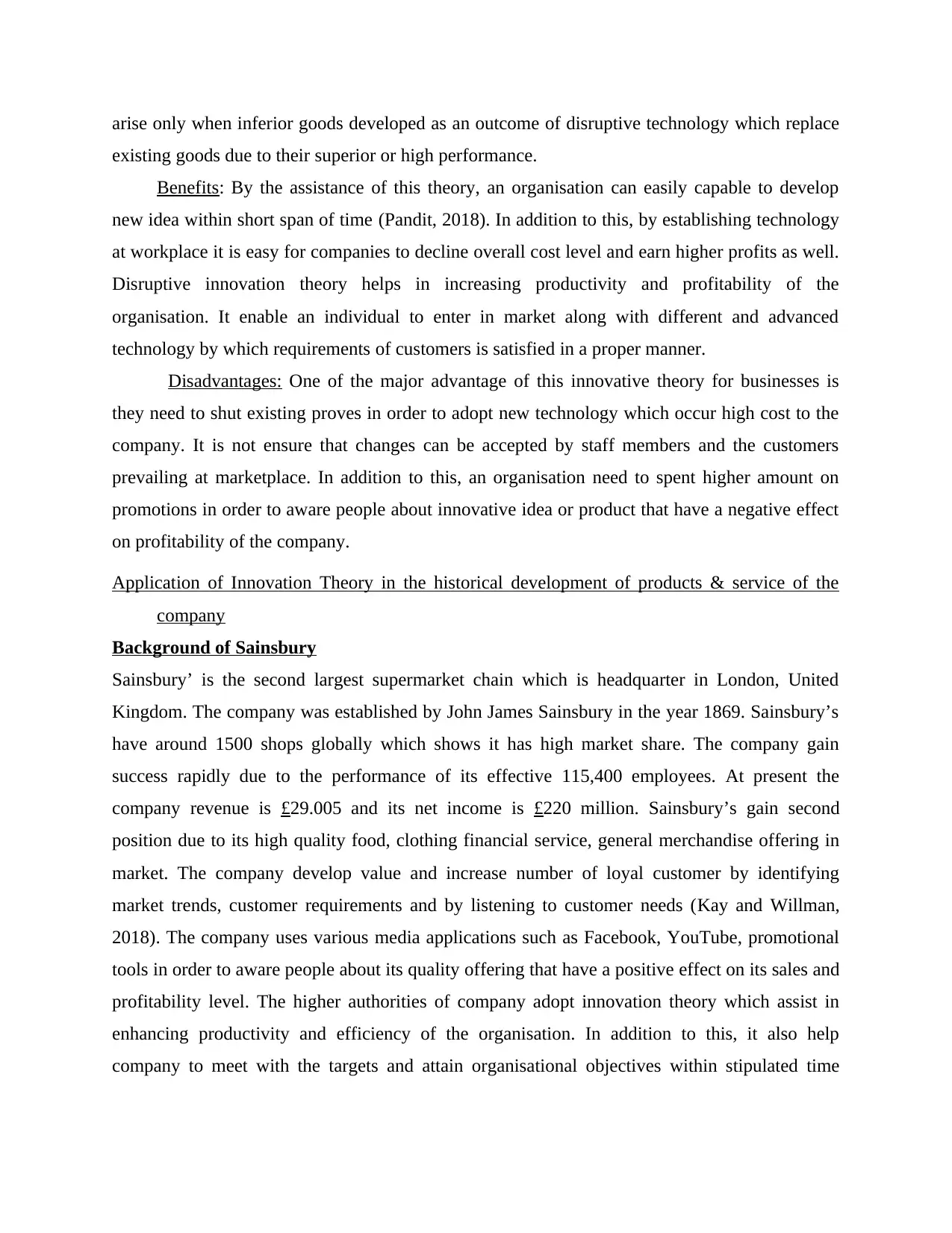
arise only when inferior goods developed as an outcome of disruptive technology which replace
existing goods due to their superior or high performance.
Benefits: By the assistance of this theory, an organisation can easily capable to develop
new idea within short span of time (Pandit, 2018). In addition to this, by establishing technology
at workplace it is easy for companies to decline overall cost level and earn higher profits as well.
Disruptive innovation theory helps in increasing productivity and profitability of the
organisation. It enable an individual to enter in market along with different and advanced
technology by which requirements of customers is satisfied in a proper manner.
Disadvantages: One of the major advantage of this innovative theory for businesses is
they need to shut existing proves in order to adopt new technology which occur high cost to the
company. It is not ensure that changes can be accepted by staff members and the customers
prevailing at marketplace. In addition to this, an organisation need to spent higher amount on
promotions in order to aware people about innovative idea or product that have a negative effect
on profitability of the company.
Application of Innovation Theory in the historical development of products & service of the
company
Background of Sainsbury
Sainsbury’ is the second largest supermarket chain which is headquarter in London, United
Kingdom. The company was established by John James Sainsbury in the year 1869. Sainsbury’s
have around 1500 shops globally which shows it has high market share. The company gain
success rapidly due to the performance of its effective 115,400 employees. At present the
company revenue is £29.005 and its net income is £220 million. Sainsbury’s gain second
position due to its high quality food, clothing financial service, general merchandise offering in
market. The company develop value and increase number of loyal customer by identifying
market trends, customer requirements and by listening to customer needs (Kay and Willman,
2018). The company uses various media applications such as Facebook, YouTube, promotional
tools in order to aware people about its quality offering that have a positive effect on its sales and
profitability level. The higher authorities of company adopt innovation theory which assist in
enhancing productivity and efficiency of the organisation. In addition to this, it also help
company to meet with the targets and attain organisational objectives within stipulated time
existing goods due to their superior or high performance.
Benefits: By the assistance of this theory, an organisation can easily capable to develop
new idea within short span of time (Pandit, 2018). In addition to this, by establishing technology
at workplace it is easy for companies to decline overall cost level and earn higher profits as well.
Disruptive innovation theory helps in increasing productivity and profitability of the
organisation. It enable an individual to enter in market along with different and advanced
technology by which requirements of customers is satisfied in a proper manner.
Disadvantages: One of the major advantage of this innovative theory for businesses is
they need to shut existing proves in order to adopt new technology which occur high cost to the
company. It is not ensure that changes can be accepted by staff members and the customers
prevailing at marketplace. In addition to this, an organisation need to spent higher amount on
promotions in order to aware people about innovative idea or product that have a negative effect
on profitability of the company.
Application of Innovation Theory in the historical development of products & service of the
company
Background of Sainsbury
Sainsbury’ is the second largest supermarket chain which is headquarter in London, United
Kingdom. The company was established by John James Sainsbury in the year 1869. Sainsbury’s
have around 1500 shops globally which shows it has high market share. The company gain
success rapidly due to the performance of its effective 115,400 employees. At present the
company revenue is £29.005 and its net income is £220 million. Sainsbury’s gain second
position due to its high quality food, clothing financial service, general merchandise offering in
market. The company develop value and increase number of loyal customer by identifying
market trends, customer requirements and by listening to customer needs (Kay and Willman,
2018). The company uses various media applications such as Facebook, YouTube, promotional
tools in order to aware people about its quality offering that have a positive effect on its sales and
profitability level. The higher authorities of company adopt innovation theory which assist in
enhancing productivity and efficiency of the organisation. In addition to this, it also help
company to meet with the targets and attain organisational objectives within stipulated time
Paraphrase This Document
Need a fresh take? Get an instant paraphrase of this document with our AI Paraphraser
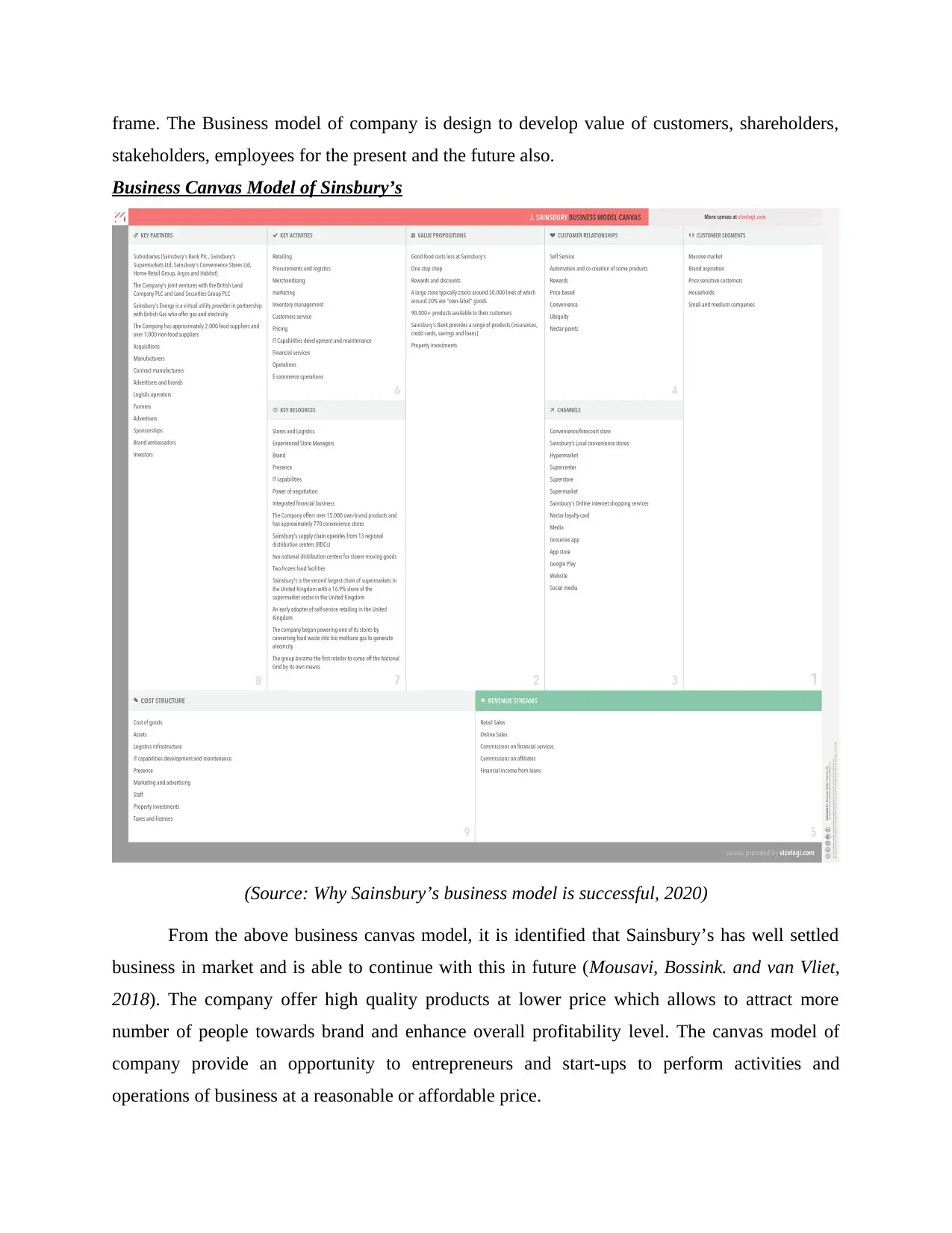
frame. The Business model of company is design to develop value of customers, shareholders,
stakeholders, employees for the present and the future also.
Business Canvas Model of Sinsbury’s
(Source: Why Sainsbury’s business model is successful, 2020)
From the above business canvas model, it is identified that Sainsbury’s has well settled
business in market and is able to continue with this in future (Mousavi, Bossink. and van Vliet,
2018). The company offer high quality products at lower price which allows to attract more
number of people towards brand and enhance overall profitability level. The canvas model of
company provide an opportunity to entrepreneurs and start-ups to perform activities and
operations of business at a reasonable or affordable price.
stakeholders, employees for the present and the future also.
Business Canvas Model of Sinsbury’s
(Source: Why Sainsbury’s business model is successful, 2020)
From the above business canvas model, it is identified that Sainsbury’s has well settled
business in market and is able to continue with this in future (Mousavi, Bossink. and van Vliet,
2018). The company offer high quality products at lower price which allows to attract more
number of people towards brand and enhance overall profitability level. The canvas model of
company provide an opportunity to entrepreneurs and start-ups to perform activities and
operations of business at a reasonable or affordable price.
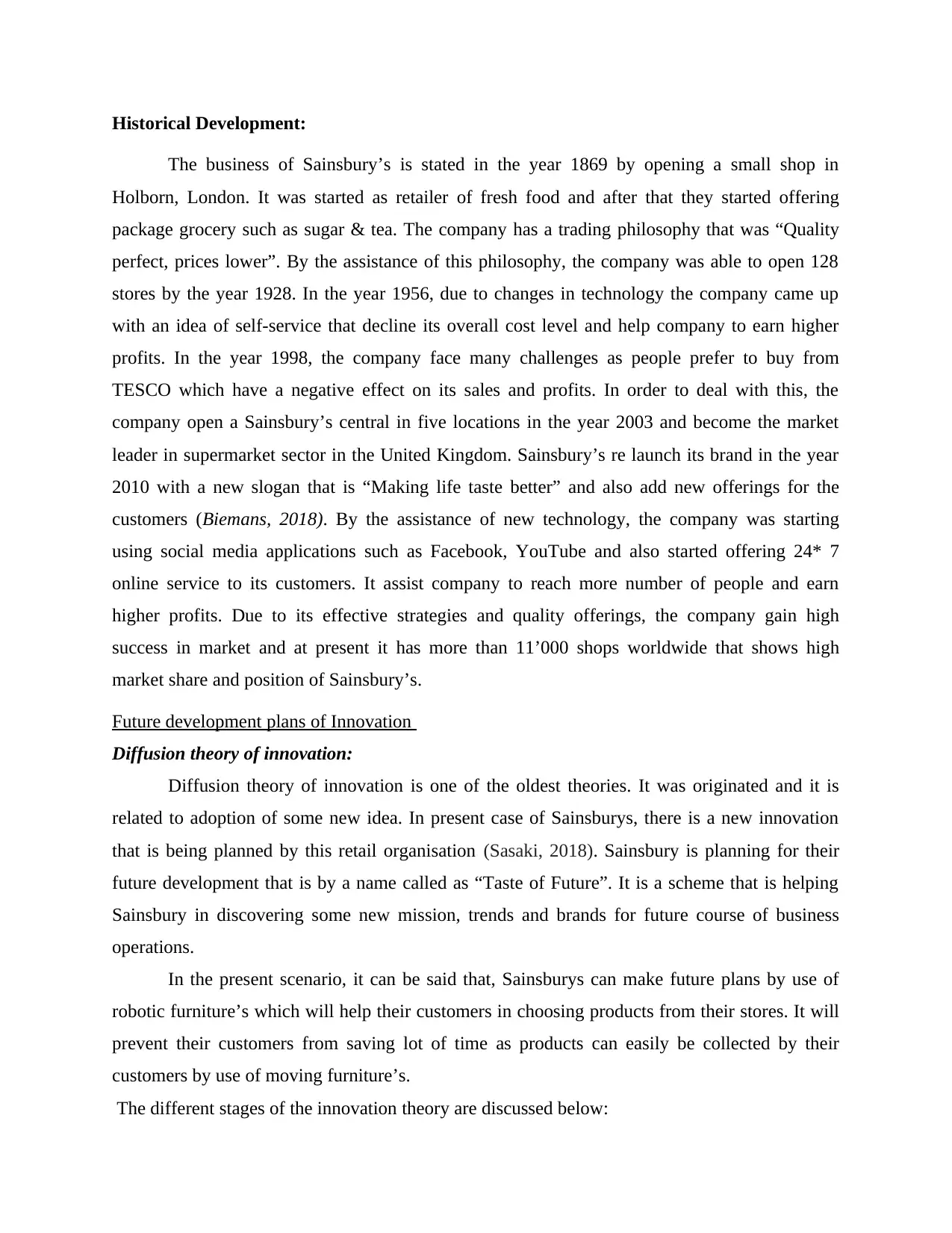
Historical Development:
The business of Sainsbury’s is stated in the year 1869 by opening a small shop in
Holborn, London. It was started as retailer of fresh food and after that they started offering
package grocery such as sugar & tea. The company has a trading philosophy that was “Quality
perfect, prices lower”. By the assistance of this philosophy, the company was able to open 128
stores by the year 1928. In the year 1956, due to changes in technology the company came up
with an idea of self-service that decline its overall cost level and help company to earn higher
profits. In the year 1998, the company face many challenges as people prefer to buy from
TESCO which have a negative effect on its sales and profits. In order to deal with this, the
company open a Sainsbury’s central in five locations in the year 2003 and become the market
leader in supermarket sector in the United Kingdom. Sainsbury’s re launch its brand in the year
2010 with a new slogan that is “Making life taste better” and also add new offerings for the
customers (Biemans, 2018). By the assistance of new technology, the company was starting
using social media applications such as Facebook, YouTube and also started offering 24* 7
online service to its customers. It assist company to reach more number of people and earn
higher profits. Due to its effective strategies and quality offerings, the company gain high
success in market and at present it has more than 11’000 shops worldwide that shows high
market share and position of Sainsbury’s.
Future development plans of Innovation
Diffusion theory of innovation:
Diffusion theory of innovation is one of the oldest theories. It was originated and it is
related to adoption of some new idea. In present case of Sainsburys, there is a new innovation
that is being planned by this retail organisation (Sasaki, 2018). Sainsbury is planning for their
future development that is by a name called as “Taste of Future”. It is a scheme that is helping
Sainsbury in discovering some new mission, trends and brands for future course of business
operations.
In the present scenario, it can be said that, Sainsburys can make future plans by use of
robotic furniture’s which will help their customers in choosing products from their stores. It will
prevent their customers from saving lot of time as products can easily be collected by their
customers by use of moving furniture’s.
The different stages of the innovation theory are discussed below:
The business of Sainsbury’s is stated in the year 1869 by opening a small shop in
Holborn, London. It was started as retailer of fresh food and after that they started offering
package grocery such as sugar & tea. The company has a trading philosophy that was “Quality
perfect, prices lower”. By the assistance of this philosophy, the company was able to open 128
stores by the year 1928. In the year 1956, due to changes in technology the company came up
with an idea of self-service that decline its overall cost level and help company to earn higher
profits. In the year 1998, the company face many challenges as people prefer to buy from
TESCO which have a negative effect on its sales and profits. In order to deal with this, the
company open a Sainsbury’s central in five locations in the year 2003 and become the market
leader in supermarket sector in the United Kingdom. Sainsbury’s re launch its brand in the year
2010 with a new slogan that is “Making life taste better” and also add new offerings for the
customers (Biemans, 2018). By the assistance of new technology, the company was starting
using social media applications such as Facebook, YouTube and also started offering 24* 7
online service to its customers. It assist company to reach more number of people and earn
higher profits. Due to its effective strategies and quality offerings, the company gain high
success in market and at present it has more than 11’000 shops worldwide that shows high
market share and position of Sainsbury’s.
Future development plans of Innovation
Diffusion theory of innovation:
Diffusion theory of innovation is one of the oldest theories. It was originated and it is
related to adoption of some new idea. In present case of Sainsburys, there is a new innovation
that is being planned by this retail organisation (Sasaki, 2018). Sainsbury is planning for their
future development that is by a name called as “Taste of Future”. It is a scheme that is helping
Sainsbury in discovering some new mission, trends and brands for future course of business
operations.
In the present scenario, it can be said that, Sainsburys can make future plans by use of
robotic furniture’s which will help their customers in choosing products from their stores. It will
prevent their customers from saving lot of time as products can easily be collected by their
customers by use of moving furniture’s.
The different stages of the innovation theory are discussed below:
⊘ This is a preview!⊘
Do you want full access?
Subscribe today to unlock all pages.

Trusted by 1+ million students worldwide
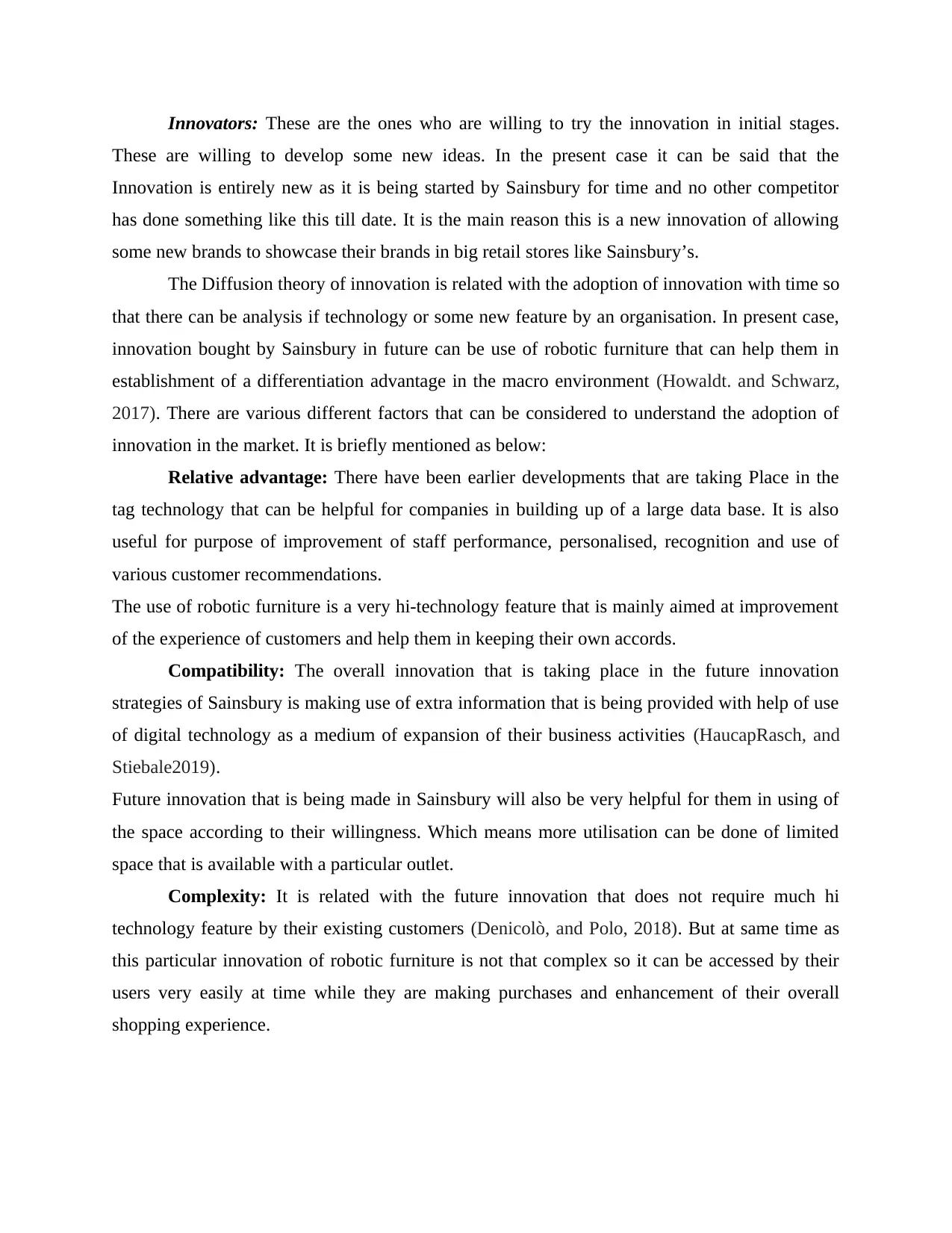
Innovators: These are the ones who are willing to try the innovation in initial stages.
These are willing to develop some new ideas. In the present case it can be said that the
Innovation is entirely new as it is being started by Sainsbury for time and no other competitor
has done something like this till date. It is the main reason this is a new innovation of allowing
some new brands to showcase their brands in big retail stores like Sainsbury’s.
The Diffusion theory of innovation is related with the adoption of innovation with time so
that there can be analysis if technology or some new feature by an organisation. In present case,
innovation bought by Sainsbury in future can be use of robotic furniture that can help them in
establishment of a differentiation advantage in the macro environment (Howaldt. and Schwarz,
2017). There are various different factors that can be considered to understand the adoption of
innovation in the market. It is briefly mentioned as below:
Relative advantage: There have been earlier developments that are taking Place in the
tag technology that can be helpful for companies in building up of a large data base. It is also
useful for purpose of improvement of staff performance, personalised, recognition and use of
various customer recommendations.
The use of robotic furniture is a very hi-technology feature that is mainly aimed at improvement
of the experience of customers and help them in keeping their own accords.
Compatibility: The overall innovation that is taking place in the future innovation
strategies of Sainsbury is making use of extra information that is being provided with help of use
of digital technology as a medium of expansion of their business activities (HaucapRasch, and
Stiebale2019).
Future innovation that is being made in Sainsbury will also be very helpful for them in using of
the space according to their willingness. Which means more utilisation can be done of limited
space that is available with a particular outlet.
Complexity: It is related with the future innovation that does not require much hi
technology feature by their existing customers (Denicolò, and Polo, 2018). But at same time as
this particular innovation of robotic furniture is not that complex so it can be accessed by their
users very easily at time while they are making purchases and enhancement of their overall
shopping experience.
These are willing to develop some new ideas. In the present case it can be said that the
Innovation is entirely new as it is being started by Sainsbury for time and no other competitor
has done something like this till date. It is the main reason this is a new innovation of allowing
some new brands to showcase their brands in big retail stores like Sainsbury’s.
The Diffusion theory of innovation is related with the adoption of innovation with time so
that there can be analysis if technology or some new feature by an organisation. In present case,
innovation bought by Sainsbury in future can be use of robotic furniture that can help them in
establishment of a differentiation advantage in the macro environment (Howaldt. and Schwarz,
2017). There are various different factors that can be considered to understand the adoption of
innovation in the market. It is briefly mentioned as below:
Relative advantage: There have been earlier developments that are taking Place in the
tag technology that can be helpful for companies in building up of a large data base. It is also
useful for purpose of improvement of staff performance, personalised, recognition and use of
various customer recommendations.
The use of robotic furniture is a very hi-technology feature that is mainly aimed at improvement
of the experience of customers and help them in keeping their own accords.
Compatibility: The overall innovation that is taking place in the future innovation
strategies of Sainsbury is making use of extra information that is being provided with help of use
of digital technology as a medium of expansion of their business activities (HaucapRasch, and
Stiebale2019).
Future innovation that is being made in Sainsbury will also be very helpful for them in using of
the space according to their willingness. Which means more utilisation can be done of limited
space that is available with a particular outlet.
Complexity: It is related with the future innovation that does not require much hi
technology feature by their existing customers (Denicolò, and Polo, 2018). But at same time as
this particular innovation of robotic furniture is not that complex so it can be accessed by their
users very easily at time while they are making purchases and enhancement of their overall
shopping experience.
Paraphrase This Document
Need a fresh take? Get an instant paraphrase of this document with our AI Paraphraser
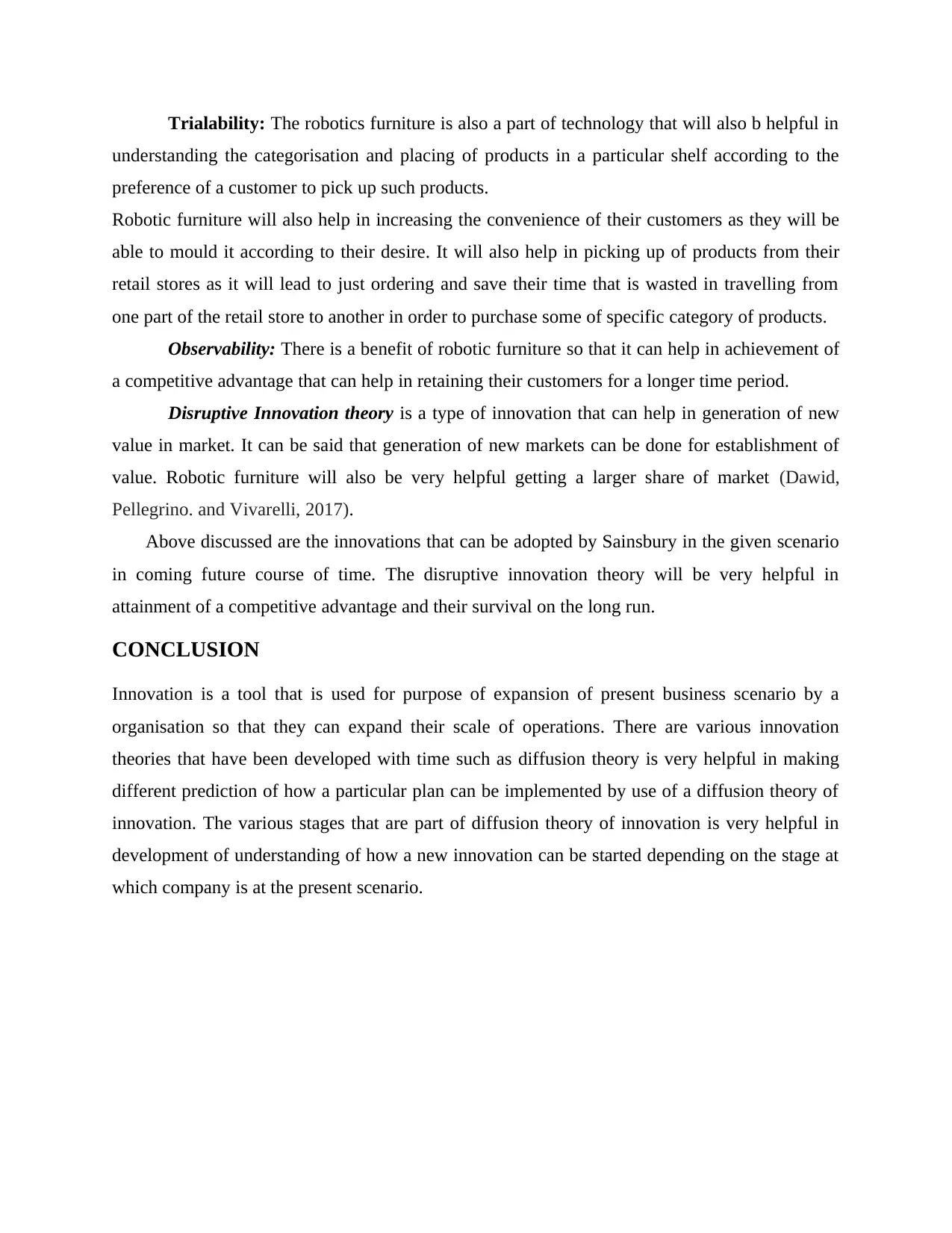
Trialability: The robotics furniture is also a part of technology that will also b helpful in
understanding the categorisation and placing of products in a particular shelf according to the
preference of a customer to pick up such products.
Robotic furniture will also help in increasing the convenience of their customers as they will be
able to mould it according to their desire. It will also help in picking up of products from their
retail stores as it will lead to just ordering and save their time that is wasted in travelling from
one part of the retail store to another in order to purchase some of specific category of products.
Observability: There is a benefit of robotic furniture so that it can help in achievement of
a competitive advantage that can help in retaining their customers for a longer time period.
Disruptive Innovation theory is a type of innovation that can help in generation of new
value in market. It can be said that generation of new markets can be done for establishment of
value. Robotic furniture will also be very helpful getting a larger share of market (Dawid,
Pellegrino. and Vivarelli, 2017).
Above discussed are the innovations that can be adopted by Sainsbury in the given scenario
in coming future course of time. The disruptive innovation theory will be very helpful in
attainment of a competitive advantage and their survival on the long run.
CONCLUSION
Innovation is a tool that is used for purpose of expansion of present business scenario by a
organisation so that they can expand their scale of operations. There are various innovation
theories that have been developed with time such as diffusion theory is very helpful in making
different prediction of how a particular plan can be implemented by use of a diffusion theory of
innovation. The various stages that are part of diffusion theory of innovation is very helpful in
development of understanding of how a new innovation can be started depending on the stage at
which company is at the present scenario.
understanding the categorisation and placing of products in a particular shelf according to the
preference of a customer to pick up such products.
Robotic furniture will also help in increasing the convenience of their customers as they will be
able to mould it according to their desire. It will also help in picking up of products from their
retail stores as it will lead to just ordering and save their time that is wasted in travelling from
one part of the retail store to another in order to purchase some of specific category of products.
Observability: There is a benefit of robotic furniture so that it can help in achievement of
a competitive advantage that can help in retaining their customers for a longer time period.
Disruptive Innovation theory is a type of innovation that can help in generation of new
value in market. It can be said that generation of new markets can be done for establishment of
value. Robotic furniture will also be very helpful getting a larger share of market (Dawid,
Pellegrino. and Vivarelli, 2017).
Above discussed are the innovations that can be adopted by Sainsbury in the given scenario
in coming future course of time. The disruptive innovation theory will be very helpful in
attainment of a competitive advantage and their survival on the long run.
CONCLUSION
Innovation is a tool that is used for purpose of expansion of present business scenario by a
organisation so that they can expand their scale of operations. There are various innovation
theories that have been developed with time such as diffusion theory is very helpful in making
different prediction of how a particular plan can be implemented by use of a diffusion theory of
innovation. The various stages that are part of diffusion theory of innovation is very helpful in
development of understanding of how a new innovation can be started depending on the stage at
which company is at the present scenario.

⊘ This is a preview!⊘
Do you want full access?
Subscribe today to unlock all pages.

Trusted by 1+ million students worldwide
1 out of 14
Related Documents
Your All-in-One AI-Powered Toolkit for Academic Success.
+13062052269
info@desklib.com
Available 24*7 on WhatsApp / Email
![[object Object]](/_next/static/media/star-bottom.7253800d.svg)
Unlock your academic potential
Copyright © 2020–2025 A2Z Services. All Rights Reserved. Developed and managed by ZUCOL.





